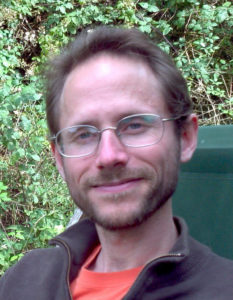Brandon Brown (Ph.D., 1997, Tate group) recently published, “Sharing our Science: How to Write and Speak STEM,” (2023, MIT Press). For more details, see https://mitpress.mit.edu/9780262546959/sharing-our-science/; the book is already garnering great reviews! Brown is Professor of Physics at the University of San Francisco. This is his 3rd book, following a biography of Max Planck and a history of the Apollo Project from the perspective of its engineers. Prof. Brown will visit OSU Physics in Spring 2024 to share his ideas on science communication in our colloquium series.
Author Archives: tatej
Physics faculty honored at College Awards Ceremony
It was a banner day for Physics at the College of Science Awards Ceremony on Tuesday, February 22, 2022 (lots of twos, too).
Liz Gire won the Frederick H. Horne Award for Sustained Excellence in Teaching Science. A master innovator in teaching, Liz earns accolades for her skill in communicating difficult topics and her ability to pitch physics at the right level for her students. A student wrote, “Her level of dedication to the genuine support and inclusion of the students in her courses is something I’ve never seen in an educator before. She backs that up with her skill and experience in education and communication that makes difficult content still accessible and enjoyable to learn.” Read more at the College of Science Impact Magazine.
Matt Graham was presented with the Industry Partnership Award for his work on harnessing waste heat. Matt has worked with several companies over the past several years on projects that have led to Ph.D. theses for his students.
Davide Lazzati earned this year’s Milton Harris Award for his outstanding work in the field of high-energy astrophysics. His pioneering considerations of electromagnetic signatures of neutron star mergers hav produced some of the most detailed predictions of compact binary mergers, perhaps one of the most exciting topic in astrophysics in the past decade. Read more at Impact Magazine.
Heidi Schellman is this year’s Gilfillan Awardee. The F.A. Gilfillan Award for Distinguished Scholarship honors faculty members in the College of Science whose scholarship and scientific accomplishments have extended over a substantial period of time, especially faculty whose research careers have had a significant impact on his or her field. Heidi’s work in neutrino physics is just part of her work leading to 700 peer-reviewed publications and an h-index of 113. She has contributed to several well-known scientific collaborations and currently serves in a leadership position for the Deep Underground Neutrino Experiment (DUNE). Read more at Impact Magazine.
Physics has four Faculty Senators
Four of the twelve faculty members representing the College of Science in the OSU Faculty Senate are from Physics. Liz Gire, Yun-Shik Lee and KC Walsh began their three-year terms in January 2022, joining David McIntyre, who completes his current term in December 2023. https://senate.oregonstate.edu/current-year-membership
Davide Lazzati wins OSU Impact Award for Outstanding Scholarship
Congratulations to Prof. Davide Lazzati , Head of Physics, who garnered the 2021 Impact Award for Outstanding Scholarship at OSU’s University Day Award ceremony on September 14th. Davide was cited for his ground-breaking work on gamma-ray bursts and neutron star mergers.

Davide and his co-workers were the first to correctly predict the electromagnetic signature of the binary neutron star merger GW170817, which was first detected through gravitational wave emission and faint gamma ray emission, then across the electromagnetic spectrum from optical to radio through various follow-up observations. This was the first event of its kind, and ushered in the era of “multi-messenger astronomy.” Lazzati & co. had laid the theoretical groundwork for this prediction over the years, most recently with two papers published before the observation of GW170817 [1,2].
After the observation of GW17081, he published the explanation for how a binary neutron star could result in the observations made. The puzzling part of the observation was that the gamma ray burst observed accompanying GW170817 was faint, and it was unclear how such faint emission could be used to associate GW170817 with a binary neutron star merger model for gamma ray bursts; the latter are observed to be very luminous and involve highly relativistic emission. Lazzati realized that a structured highly relativistic jet surrounded by slower and less energetic material produces afterglow emission that brightens characteristically with time, exactly as was observed in GW170817. Furthermore, he showed how to constrain the geometry of the jet and surrounding material using the observational data. This confirmed a single origin/explanation for short gamma ray bursts and binary neutron star mergers [3].
The nominators noted Davide’s impact not only on science, but also on students through his teaching and mentorship. His astrophysics research program draws many students. Two of his most successful graduate students are McNair Fellow Tyler Parsotan, who also received a NASA FINESST grant and is now a postdoc at NASA Goddard Space Flight Center in Maryland; and Black student leader, Isabel Rodriguez who graduated with an M. S. in Physics and received the Harriet “Hattie” Redmond Award for her groundbreaking work to improve diversity in Physics and beyond. He has also mentored over a dozen OSU undergraduate research dissertation projects and undergrads enthusiastically line up to join his research group.
The full list of award recipients is on the Awards Day website at https://universityday.oregonstate.edu/award-recipients.
[1] D. Lazzati, D. Lopez-Camara, M. Cantiello, B. J. Morsony, R. Perna, J. C. Workman, “Off-axis Prompt X-Ray Transients from the Cocoon of Short Gamma-Ray Bursts,” The Astrophysical Journal Letters, 848, L6 (2017) (https://arxiv.org/abs/1709.01468)
[2] D. Lazzati, A. Deich, B. J. Morsony, J. C. Workman, “Off-axis emission of short γ-ray bursts and the detectability of electromagnetic counterparts of gravitational-wave-detected binary mergers,” Monthly Notices of the Royal Astronomical Society, 471, 1652 (2017) (https://arxiv.org/abs/1610.01157)
[3] D. Lazzati, R. Perna, B. J. Morsony, D. Lopez-Camara, M. Cantiello, R. Ciolfi, B. Giacomazzo, J. C. Workman, “Late Time Afterglow Observations Reveal a Collimated Relativistic Jet in the Ejecta of the Binary Neutron Star Merger GW170817,” Physical Review Letters, 120, 241103 (2018) (https://arxiv.org/abs/1712.03237).
Pritha Biswas receives Honorable Mention at the 2021 AVS Meeting
Pritha Biswas presented her work on TiO2 polymorphs at the 2021 Symposium of the Pacific Northwest Chapter of the American Vacuum Society held at Oregon State University from 8-10 September. She received an Honorable Mention in the Graduate Student Oral Presentation category and a cash award. Congratulations!

Astronomy Club Virtual Star Party: Galaxies and Globular Clusters
Rosalyn Fey, OSU Astronomy Club Secretary
On May 17, 2021, the Astronomy Club hosted a virtual star party featuring Tom Carrico, local amateur astrophotographer and instructor of astrophotography at OSU. Tom used his telescope in Dark Sky, New Mexico to remotely image the night sky and give everyone a chance to make astronomical observations from the comfort and safety of their homes.
The party started with a presentation from Elaine Swanson, a post-baccalaureate student and founder of OSU’s Astrobotany Research Group, and continued with 2 hours of real-time astrophotography image capture and processing. Tom imaged some classic astronomical objects, such as the Sombrero Galaxy (M104), and also took requests from participants. Favorite objects included the Pinwheel Galaxy (M101), the Owl Nebula (M97), the Ring Nebula (M57), and the Great Globular Cluster (M13). Other objects of astronomical interest included M87, the galaxy which hosts the supermassive black hole first imaged in 2019 by an international collaboration using the network of telescopes known as the Event Horizon Telescope.
Participants learned about each imaged object, and about the equipment, software and procedures used for remote astrophotography. Tom covers many of these topics in PH299: Astrophotography and Astronomy, currently offered in spring term.
The Astronomy Club plans to continue hosting virtual star parties with Tom in the future to increase accessibility of night observations, and engage more people in this exciting experience! Please join us at our next virtual star party! For information about our club and events, visit our website at https://blogs.oregonstate.edu/astronomyclub/.

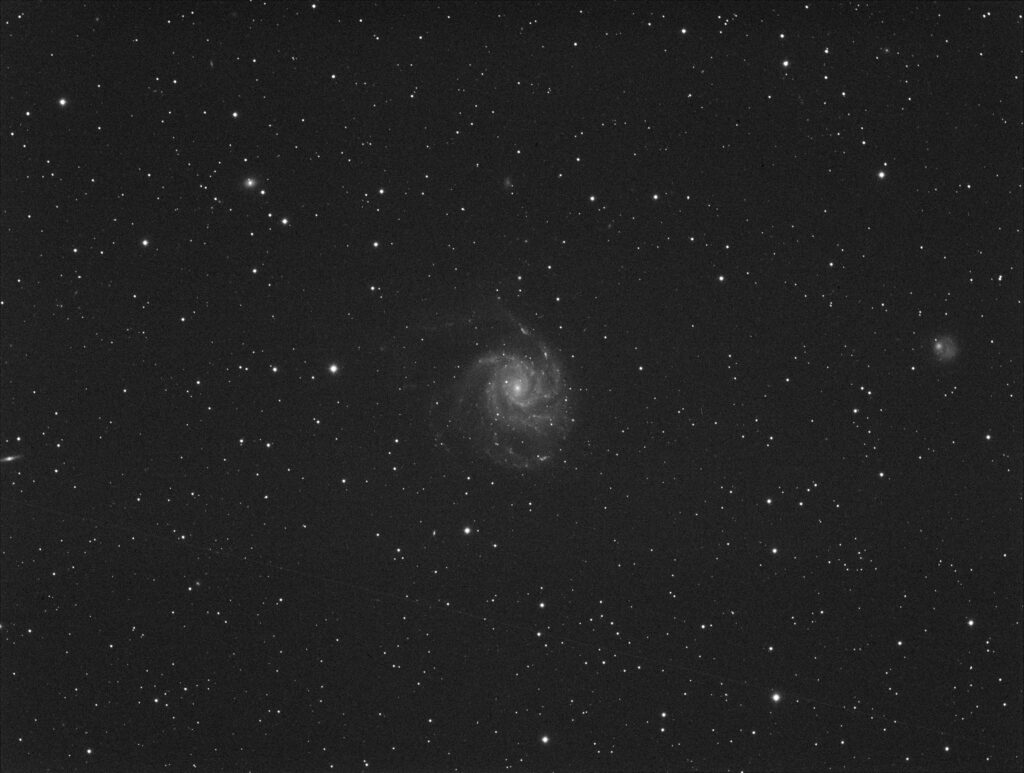
Isabel Rodriguez is the 2021 Harriet “Hattie” Redmond Awardee!

Congratulations to Isabel Rodriguez, M.S. for being the 2021 recipient of the Harriet “Hattie” Redmond Award! This award celebrates a member of the OSU community who works as an agent of change in service of racial justice and gender equity. This ” Breaking Barriers” award is sponsored by the President’s Commission on the Status of Women (PCOSW), the Office of Institutional Diversity (OID), the Office of the Provost and OSU Athletics.
https://leadership.oregonstate.edu/pcosw/events/breakingbarriers
Isabel is a brilliant example of a scientist who works tirelessly and effectively for change in service of racial justice and gender equality. The STEM culture at Oregon State University is changing profoundly because of her influence. As a Black woman in astrophysics, she has expertly navigated the terrain in this white-male-dominated field to emerge as a powerful example to other marginalized people of how to be successful on their own terms and teaching her mentors to change the ways they interact with their students.
Isabel has been a powerful agent of change in our Department and College. She has challenged her research group, her peers, her mentors and the administration to look at our workplace differently and through the eyes of those marginalized. As an elected member of the graduate student committee, she helped lead discussions among the faculty and students in a series of Town Hall meetings that ultimately resulted in significant changes to the physics graduate program to make it more fair, flexible, and inclusive. She has also been an important member of the departmental DICE committee and a founding member of CoSMAC, the College of Science Multidisciplinary Antiracism Coalition, which advocates for the adoption of antiracist policies, practices, and actions in the College. She was also Vice President of the Black Graduate Student Association, where she organized regular on-campus events to foster a sense of community and belonging for Black undergraduate and graduate students. For her positive, measured and always relentless advice and guidance, Isabel is a worthy member of a spectacular group of leaders that have been recognized with the Harriet “Hattie” Redmond Award.
Thank you for your service Isabel, and for raising our collective consciousness.
OSU alum Prof. Briony Horgan plays a critical role in 2020 NASA Mars rover mission
Briony Horgan (B.S. OSU Physics, 2005), Associate Professor of Planetary Sciences at Purdue University, is a member of the science team that will launch the NASA Mars rover Perseverance in the next few weeks. The rover will travel to Jezero Crater, which preserves evidence of a time when rivers flowed on Mars. Prof. Horgan led a study of the mineralogy of the site, which produced one of the major results that contributed to its selection. She was also on the team that designed the camera that will be the scientific eyes for Perseverance. Well done Briony – and best of luck with the mission!
For the full story and image credit, see this link.
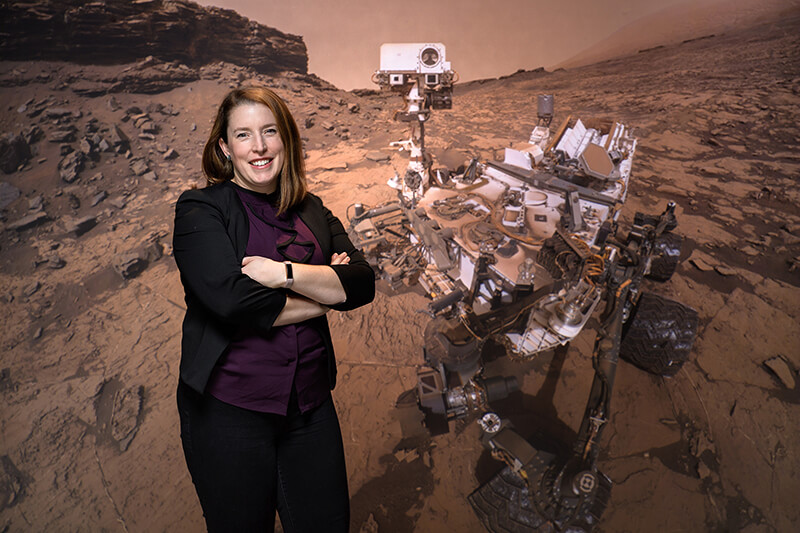
2020 SURE Awards
Physics students and faculty are well-represented in the College of Science 2020 Summer Undergraduate Research Experience (SURE) Awards. These awards provide 11-week employment in the summer for students, though this year, because of closures during the covid-19 pandemic, the research may have to be stretched out over the academic year.
This year’s physics student awardees are:
Hunter Nelson advised by Tuan Pham (Mathematics)
Rohal Kakepoto advised by Janet Tate
Alan Schultz advised by Hoe Woon Kim (Mathematics)
Alexander van Balderen advised by Liz Gire
Jessica Waymire advised by Matt Graham
Ryan Wong advised by Bo Sun
Students from other departments working with Physics faculty are:
Emily Gemmill, (Biochemistry & Biophysics), advised by Weihong Qiu
Ruben Lopez (BioHealth Sciences) advised by Bo Sun
Congratulations all!
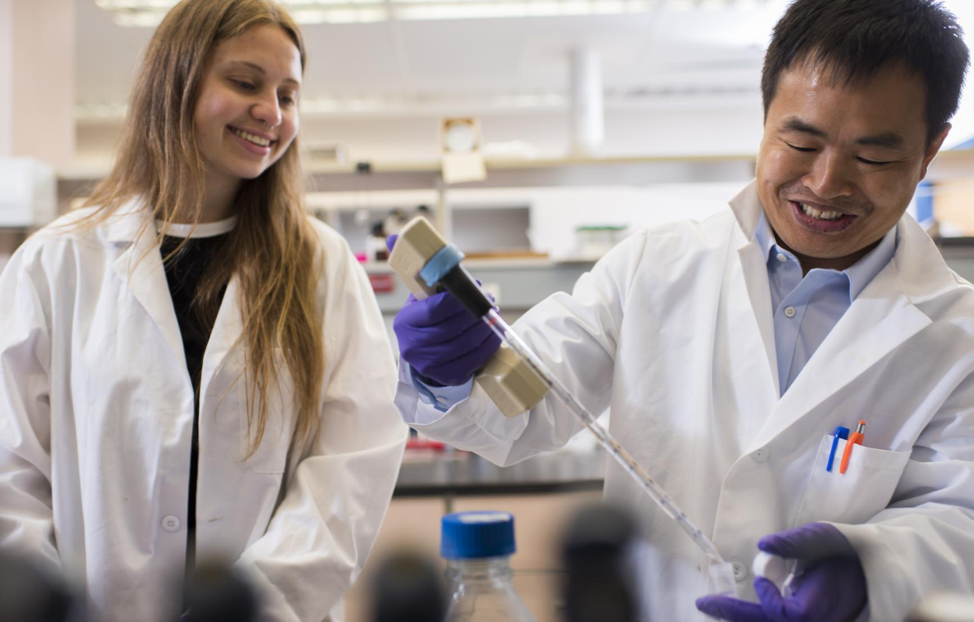
David Roundy’s PH366 Computational Physics Lab models epidemic like COVID-19
When the novel coronavirus pandemic hit, the Physics Department, like the rest of Oregon State University, scrambled to get its course offerings ready for remote learning in a few days. Professor David Roundy and his teaching team scrambled as hard as anyone – and incorporated some beginning epidemic modeling into the computational physics class so that the students would begin to acquire the skills that will serve them well as members of the technological community of which they are now junior members.
About the class:
PH366 – Computational Physics – is a course in which students learn how to solve mathematical equations in real-world, complex situations where analytical, “pencil-and-paper” solutions are far too difficult. For example, it’s easy for a student in Introductory Physics to solve a simple differential equation to find a solution in the form of an equation that describes how a ball falls towards the earth under the influence of gravity, a constant force near the earth’s surface. But add extra forces that describe real conditions like air resistance, wind and the earth’s rotation, and a simple equation to describe position as a function of time is impossible. The computer solves the problem numerically, chopping it up into very small time slices and finding a position and velocity for each of the times based on what is was at the previous time. In the PH36x Computational Physics series, students learn techniques to find numerical solutions to many differential equations and they can explore very complex, real-world situations. Roundy has chosen the Python programming language for this class, but the lessons are applicable to any language. In real physics research, few problems are already worked out in a textbook and numerical methods to solve them improve all the time, so the best information is often distributed all over the internet. Physics students must learn to navigate the body of existing literature and identify what information they need to solve a problem.
Another view of the solution shows the difference between displaying results on a linear plot and a logarithmic plot. The logarithmic plot (below) highlights the infection and recovery numbers, which are a small fraction of the overall population and we’d be tempted to ignore the fact that there are hundreds of thousands of sick people if we saw only the linear plot (above).
An example that David Roundy chose for the Spring 2020 Computational Physics course was about the spread of an epidemic, like covid-19. It was all everyone was talking about, and he wanted the students to learn how their new computational skills are at the heart of epidemiological modeling that gives us the information to understand and mitigate the spread of the coronavirus. This isn’t an accurate model, Roundy stresses, but it has valuable elements – start with a simple model, probably unrealistic, test it, make sure it works as expected. Add some complexity, test that, and then proceed. In his easy-to-read description at the PH366 course website, Roundy shows students how to model exponential growth – the increase in number of covid-19 cases is proportional to the number of cases: dI/dt = RI. Then you have to add in the real-world fact that the population is finite (with a doubling time of 1 day, the world human population would be infected in a little over a month). Some people recover and have immunity (we hope), so that must be factored into a more realistic model. More complexity comes in when you consider how long infected people are contagious, and whether there is a period of immunity following recovery.
Actually, the problem is not too hard to set up – it’s the solution that becomes tedious. That’s the beauty of computers is that they don’t care about tedium. They swiftly toil through tedious calculations without becoming bored or tired and their error rate is effectively zero! The humans have to set up the problem correctly, though, otherwise the results are meaningless. And this is the skill that Roundy teaches his students. The screenshots below show an example of the students’ work in PH366, with the by-now-familiar plot of an exponential rise in infections at the start, with a peak and fall. We see the basic recovery and death trends, too.
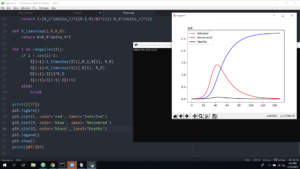
Another view of the solution shows the difference between displaying results on a linear plot and a logarithmic plot. The logarithmic plot (below) highlights the infection and recovery numbers, which are a small fraction of the overall population and we’d be tempted to ignore the fact that there are hundreds of thousands of sick people if we saw only the linear plot (above).

Julian Wulf, one of the Physics majors currently in PH 366 commented, “My favorite part of the class is how it allowed me to model physical situations that were too complex to picture, or model by hand. I have found it quite rewarding to finish coding something and have it modeled in front of me, a model that is often easy to adjust to new circumstances.” It’s easy to see how Julian would relish the challenge of modeling a much more complicated solution that factored in even more complexity such as social contact and real transmission rates.
Teaching in the age of coronavirus:
To deliver PH366, David Roundy goes into Weniger Hall by himself every Tuesday and Thursday and turns on some 20 computers with separate Zoom sessions running (see the panorama view below). The 40 students and the 4 TAs (teaching assistants) log in from their remote locations. The students implement Roundy’s “pair programming” strategy where they decide how to solve the problem and code in pairs, each providing the crucial check on the other to ensure that the steps make sense. They constantly question their results, and look up techniques to improve their code and to interpret the results. It’s a real-world programmer situation! Roundy and the teaching assistants hop between the Zoom breakout rooms to discuss with each pair of students how to troubleshoot and debug their code. It wasn’t easy for the instructors to change their mode of operation from in-person to remote learning. TA Elena Wennstrom comments, “At the beginning, our TA meetings were devoted to brainstorming possible class formats, testing the limits of our Zoom powers, and discussing issues and possible improvements to the class we had the day before. Now we are more able to focus on the content, and trying out the assignments ourselves (like usual). I’m really proud of the system we’ve developed. Classes go surprisingly smoothly, and the time flies.” Wennstrom adds that she gets more and better questions from the students in the remote mode. Roundy remarks that he will offer this new mode of teaching to students with seasonal influenza in “normal” times to help curb the spread of that particular virus.

The students’ response:
The students agree. Julian Wulf says, “I think the transition to remote learning has mostly gone smoothly. There has been a rapid increase in how well things are being communicated remotely, as well as an increasing ability of the teaching assistants and professor to respond to difficulties we encounter while programming. I find myself looking forward to the continued improvement as each class has run more smoothly than the last, with the teaching assistants and Professor Roundy being increasingly able to react to difficulties people encounter by jumping in and out of Zoom breakout rooms to help.”
As “newbie programmer”, Wulf feels that the pair programming method helped him get over an initial fear of programming, and that he has learned to appreciate how quickly he learns to solve new problems. He found the disease and epidemic modeling project interesting, intellectually stimulating and fun.
Wulf says that the coding skills he is developing will be useful in the future, and that they have already entirely changed his perspective. He now routinely plots equations in Mathematica to visualize a physical situation, and his new skills make the task “pain-free” and fun rather than being as a dreaded chore.
Former Physics major John Waczak, now a graduate student in Physics at the University of Texas at Dallas, offers similar observations about the Computational Physics series. He says that Computational Physics is an incredibly powerful tool for building physics understanding and to tackle problems that are otherwise unsolvable. It also enables him to create detailed visualizations of just about anything, and those visualizations don’t have to be static! Computers makes it possible to manipulate 2-, 3-, and even 4-dimensional data and create animations. “I have been using this skill a lot lately to visualize results in my [graduate] classes,” he says. Waczak further appreciates that PH36x made him an autodidact. “Dr. Roundy encouraged us to become familiar with the documentation and common programming forums like Stack Exchange. Instead of giving us working code to start with, we had to learn how to diagnose bugs and navigate the wide variety of (often incorrect) answers that exist online.” This meant that he became better programmer (and physicist). “I certainly do not know all of the tools and features that exist in the python programming language. What I do understand is how to evaluate the credibility of a resource and how to extract what’s important from the large body of existing information.”
Prof. Roundy’s PH366 covid-19 assignment is available at http://sites.science.oregonstate.edu/~roundyd/COURSES/ph366/epidemic.html
The TAs for the class are Elena Wennstron, Kira McCoy, Alex Kuepper and Steven Neiman.
David Roundy is an Associate Professor of Physics at Oregon State University, and has been teaching and researching at OSU since 2006. His work in computational physics spans exotic superconductors, metal-organic frameworks, classical and quantum density functional theory, biological motor proteins and many other topics. He invented the Darcs version control software. He is a member of the Paradigms in Physics team with significant funding from the National Science Foundation for education-related research focusing on thermal physics and computational physics.
